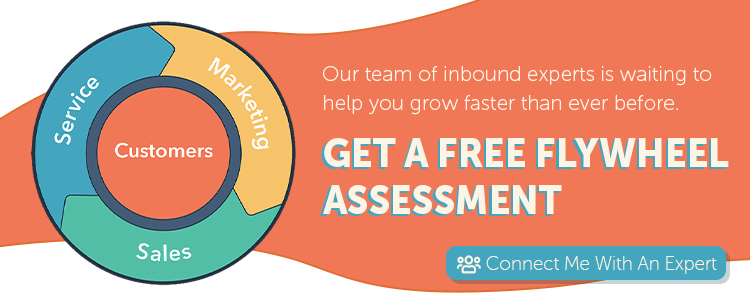Inbound continues growing since HubSpot co-founder and CEO Brian Halligan first coined the phrase over a decade ago.
While the term "inbound" is often associated with marketing, it reaches far beyond marketing efforts. And it's more than just another trendy business buzzword.
Inbound is an extension of one of the most important human skills – empathy.
And inbound should be in everything you do, at every level of your business. This is where HubSpot's flywheel framework comes in. It is leading the way we put inbound into practice.
Authors Dan Tyre and Todd Hockenberry dive into great detail on why inbound organizations are the future of business in their book, Inbound Organization: How to Build and Strengthen Your Company's Future Using Inbound Principles.
"Inbound has already become more than just a marketing strategy," they write. "Inbound today has come to represent a way of thinking, a mindset, and a philosophy for growing your business in the 21st century ... Buyers will crave even more human treatment from companies; they will seek only helpful companies, not self-serving ones.
Human, helpful, relevant. Inbound embodies these ideas. The future belongs to the inbound organization."
As you're transforming your business, stick to these five simple tenets of an effective inbound organization.
1. Relationships Over Revenue
This aligns with the inbound philosophy of “help first.” Simply put, in life and in business, you have to give to receive.
As entrepreneur, author, and speaker Gary Vaynerchuk often encourages, stay focused on playing the long game. He shares this advice in various forms, including this Instagram post.

His messaging has been consistent for years, and it aligns with the inbound philosophy. This is more than just a saying. It's a way of life.
Face the truth: client situations change over time. For example, a client might start off well but run into financial issues. This can cause them to pause their services with you or scale back.
They might even seek internal training so they can take over their own marketing department.
While in the moment, it might seem like these are major losses for your business, they're actually excellent opportunities for you to foster. This doesn’t necessarily cause lost revenue for you in the long run.
This is part of why we don’t hold clients to contracts: the long-term relationship is far more important.
We’ve had clients leave for budget reasons and come back to us once their budgets open back up. We also receive referrals from former clients, which carries a lot of weight in the inbound organization business landscape.
In fact, most companies say word of mouth is their best source of referrals. This indicates a clear takeaway: Your customers should be at the heart of all of your business strategies.
When you focus more on relationships than your monthly revenue, you're setting your company up for long term, sustainable success.
2. Human to Human, Not Just B2B or B2C
Regardless of if you’re B2C or B2B, there is an underlying truth you can't deny – you’re interacting with other human beings.
They have their own personal and professional challenges, and the more you can tap into those and connect human to human, the better off you are at building those relationships that contribute to your growth.
This is why it’s essential to build personal, authentic relationships with points of contact (POC). If your account manager struggles to build a friendly, positive rapport with your POC, this will be a major friction point.
There will always be concerns about how meetings go and how productive client calls will be.
This is why we emphasize the value of strong communication skills in all of our employees, especially those who are client facing. Our inbound marketing consultants (IMCs) have strong speaking skills, but they also excel at written communications.
For example, following every interaction they have with a POC, they send meeting recaps to confirm that all verbal communications were correctly interpreted on both sides. This eliminates issues down the road and brings miscommunications to light.
Remember, you’re solving for humans and speaking to humans. So be human! Build rapport, make small talk; get to know clients on a personal level and establish a friendly connection.
3. Culture, Not Cogs
The human element doesn’t just extend outward to your customers. It works internally as well.
Your employees are people, not replaceable cogs in a machine.
If you treat employees like cogs, they’re going to act like it. They will likely not go above and beyond. They won’t want to grow with you either.
Not only does this impact your profitability (turnover and hiring is costly), but it also can tarnish customer relationships. The more your company gels and works well together, the more that shines through. Customers see that and want to work with you.
Your employees’ enthusiasm can be infectious and get your customers equally excited. The “do your job and shut your mouth” culture is toxic and will fail you repeatedly. Customers can sense when your employees don’t want to be there working for you.
Happy employees feel respected and valued as people, and they will treat customers like people too. They’re also better equipped to feel empowered and ready to solve customers’ problems as they arise.
4. Helpful, Not Harassing
Adding value at every stage of the flywheel, in every area of your company, is essential. This ties back into the “help first” concept.
If you’re not being helpful or if you're harassing prospects, leads, and customers, you’re damaging the entire experience.
In the world of marketing, this is a matter of content plus context. It’s being ready to step in whenever your audience needs you to deliver relevant, helpful information tailored to where they are in the buyer’s journey. It’s not about gloating about your past achievements to impress them.
In terms of sales, people are savvy to your process nowadays. They know you’re in business and striving to make money. If you establish your company as a go-to resource for helpful, relevant information, your sales team can earn trust and become an authority figure for prospects.
Bottom line: When you focus on being helpful, you're betting on the fact that your audience fully sees and understands your altruistic values.
5. Synergy Over Silos
Yep. I said it. Synergy.
We all know this is a cliche, so get your groans and cringes out of the way.
Despite this buzzword being far overused, it actually applies perfectly to this inbound organization tenet.
The concept of synergy is simple: it's the state you attain when two or more things work together to produce an effect that exceeds the sum of the individual components.
In other words, synergy is what gets your entire organization on the flywheel. When all teams work together, breaking down those pesky silos, they can better serve the customer at every touchpoint.
We have seen this common struggle – sales works completely separate from marketing, so marketing can't deliver the right leads and sales doesn't know exactly how to personalize presentations and close deals.
Think of your marketing, sales, and service teams in terms of The Wizard of Oz. Marketing pitches the yellow brick road and shows leads how to get to the Emerald City. Sales is waiting at the gates, ready to show prospects how to get in. Then, service exists in the walls of the city to continually delight customers.
If these teams aren't actively communicating and delivering a consistent experience, leads, prospects, and customers will notice. Sales will wonder what leads need help with when they arrive at the city's gates. Service won't know what exactly the customer was sold and what sales and marketing promised them.
This disconnect can also lead to overpromising and underdelivering, which can hurt your reputation. Sales might overpromise to close a deal, then service teams are stuck scrambling to hit an impossible deadline.
Ultimately, the customer suffers the most from your silos. Your internal fighting and missed deadlines sets the customer up to fail.
But by putting relationships over revenue, you could better serve customers. Your teams work together to ensure every promise made to your prospects, leads, and customers is realistic and attainable. Also, when every team is on the same page, they can quickly adjust deadlines or offer alternative solutions in real time.
To break down silos between all teams, like marketing, sales, and service, start at the top. Department heads and VP/director level leadership needs to communicate effectively to serve a common goal.
When synergy starts on the top tier, leadership can educate and spread synergy down to mid level and lower level employees. Departments can stop focusing just on department goals and start contributing to your bigger picture goals.
With these five tenets in mind, you're ready to transform your business to an inbound organization. More importantly, you're prepared to lead the future of business.


Eric Baum
Eric is the CEO / Founder of Bluleadz. His passion is growing businesses and listening to Jimmy Buffet. Oh yeah, and golf when he can find the time.